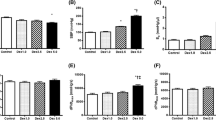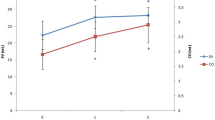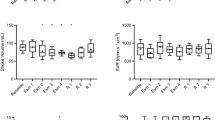Summary
Although pentobarbital has been found to depress myocardial function, the magnitude of its direct effects on ventricular contraction at anesthetic concentrations has not been well quantified. The direct effects of pentobarbital on left ventricular function were measured by employing an isolated canine heart preparation with a blood oxygenator. Seven hearts were perfused with blood, dextran, and perfluorochemical artificial blood. Ventricular function was evaluated using the slope of the end-systolic pressure-volume relationship (Ees) and the maximal rate of pressure development (dP/dtmax) in ventricles contracting isovolumically in control, after a low dose (13 µg/ml), and after a high dose (48 µg/ml) of pentobarbital. These concentrations represent one-half and two times the typical value (25 µg/ml) found to produce anesthesia in canines (assessed by tail clamp or blink reflex). The low dose of pentobarbital did not produce clear-cut depression in contractile function. The high dose of pentobarbital produced significant reductions of Ees, and dP/dtmax:Ees decreased 29%, from a control of 4.30 ± 0.84 to 3.05 ± 0.49 mmHg/ml and dP/dtmax decreased 24%, from a control of 909 ± 148 to 695 ± 173 mmHg/s. Thus, the threshold for the direct depressant effect of pentobarbital on ventricular function falls within the range of half to double the typically-reported anesthetic concentrations.
Similar content being viewed by others
References
Davies AO, McCans JL (1979) Effects of barbiturate anesthetics and ketamine on the force-frequency relation of cardiac muscle. Eur J Pharmacol 59:65–73
Frankl WS, Poole-Wilson PA (1981) Effects of thiopental on tension development, action potential, and exchange of calcium and potassium in rabbit ventricular myocardium. J Cardiovasc Pharmacol 3:554–565
Unruh HW, Wang R, Bose D, Mink SN (1991) Does pentobarbital anesthesia depress left ventricular contractility in dogs? Am J Physiol 261:H700-H706
Manders WT, Vatner SF (1976) Effects of sodium pentobarbital anesthesia on left ventricular function and distribution of cardiac output in dogs, with particular reference to the mechanism for tachycardia. Circ Res 39:512–517
Nash CB, Davis F, Woodbury RD (1956) Cardiovascular effects of anesthetic doses of pentobarbital sodium. Am J Physiol 185:107–112
Priano LL, Traber DL, Wilson RD (1969) Barbiturate anesthesia: An abnormal physiologic situation. J Pharmacol Exp Ther 165:126–135
Piatt JH, Schiff SJ (1984) High dose barbiturate therapy in neurosurgery and intensive care. Neurosurgery 15:427–444
Traeger SM, Henning RJ, Dobkin W, Gianotta S, Weil H, Weiss M (1983) Hemodynamic effects of pentobarbital therapy for intracranial hypertension. Crit Care Med 11:697–701
Peiss CN, Manning JW (1964) Effects of sodium pentobarbital on electrical and reflex activation of the cardiovascular system. Circ Res 14:228–235
Vatner SF, Braunwald E (1975) Cardiovascular control mechanisms in the conscious state. New Engl J Med 293:970–976
Hosomi H, Sagawa K (1979) Effect of pentobarbital anesthesia on hypotension after 10% hemorrhage in the dog. Am J Physiol 236:H607-H612
Zimpfer M, Manders WT, Barger AC, Vatner SF (1982) Pentobarbital alters compensatory neural and humoral mechanisms in response to hemorrhage. Am J Physiol 243:H713-H721
Zimpfer M, Sit SP, Vatner SF (1981) Effects of anesthesia on the canine carotid chemoreceptor reflex. Circ Res 48:400–406
Gilmore JP (1965) Pentobarbital sodium anesthesia in the dog. Am J Physiol 209:404–408
Steiner SH, Calvin HR (1967) The effects of anesthesia with pentobarbital on hemodynamics and arterial blood gases in splenectomized dogs. J Thorac Cardiovas Surg 54:592–598
Suga H, Sagawa K (1974) Instantaneous pressure-volume relationships and their ratio in the excised, supported canine left ventricle. Circ Res 35:117–126
Suga H, Sagawa K (1977) End-diastolic and end-systolic ventricular volume clamper for isolated canine heart. Am J Physiol 233:H718-H722
Janicki JS, Reeves RC, Weber KT, Donald TC, Walker AA (1974) Application of a pressure servo system developed to study ventricular dynamics. J Appl Physiol 37:736–741
Mason DT (1969) Usefulness and limitations of the rate of rise of intraventricular pressure (dp/dt) in the evaluation of myocardial contractility in man. Am J Cardiol 23:516–527
Frederiksen MC, Henthorn TK, Ruo TI, Atkinson AJ Jr (1983) Pharmacokinetics of pentobarbital in the dog. J Pharmacol Exp Ther 225:355–360
Nattel S, Wang Z, Matthews C (1990) Direct electro-physiological actions of pentobarbital at concentrations achieved during general anesthesia. Am J Physiol 259:H1743-H1751
Nayler WG, Szeto J (1972) Effect of sodium pentobarbital on calcium in mammalian heart muscle. Am J Physiol 222:339–344
Urthaler F, Krames BL, James TN (1974) Selective effects of pentobarbital on automaticity and conduction in the intact canine heart. Cardiovasc Res 8:46–57
Amlie JP, Owren T (1979) The effect of prolonged pentobarbital anesthesia on cardiac electrophysiology and inotropy of the dog heart in situ. Acta Pharmacol Toxicol 44:264–271
Baum D, Halter JB, Taborsky GJ Jr, Porte DP Jr (1985) Pentobarbital effects on plasma catecholamines: Temperature, heart rate, and blood pressure. Am J Physiol 248:E95-E100
Cox RH, Bagshaw RJ (1979) Influence of anesthesia on the response to carotid hypotension in dogs. Am J Physiol 237:H424-H432
Vatner SF, Franklin D, Braunwald E (1971) Effects of anesthesia and sleep on circulatory response to carotid sinus nerve stimulation. Am J Physiol 220:1249–1255
Exley KA (1954) Depression of autonomic ganglia by barbiturates. Br J Pharmacol 9:170–181
Cox RH (1972) Influence of pentobarbital anesthesia on cardiovascular function in trained dogs. Am J Physiol 223:651–659
Van Citters RL, Franklin DL, Rushmer RF (1964) Left ventricular dynamics in dogs during anesthesia with alpha-chloralose and sodium pentobarbital. Am J Cardiol 13:349–354
Barlow G, Knott DH (1964) Hemodynamic alterations after 30 minutes of pentobarbital sodium anesthesia in dogs. Am J Physiol 207:764–766
Shabetai R, Fowler NO, Hurlburt O (1963) Hemodynamic studies of dogs under pentobarbital and morphine chloralose anesthesia. J Surg Res 3:263–267
Howell CD, Horvath SM (1959) Reproducibility of cardiac output measurements in the dog. J Appl Physiol 14:421–423
Kass DA, Maughan WL (1988) From “Emax” to pressure-volume relations: A broader view. Circulation 77:1203–1212
Burkhoff D, Yue DT, Franz MR, Hunter WC, Sagawa K (1984) Mechanical restitution of isolated perfused canine left ventricles. Am J Physiol 246:H8-H16
Murray PA, Vatner SF (1979) Alpha-adrenoceptor attenuation of the coronary vascular response to severe exercise in the conscious dog. Circ Res 45:654–660
O'Rourke RA, Bishop VS (1971) Cardiovascular hemodynamics in the conscious dog. Am Heart J 81:55–60
Freye E (1974) Cardiovascular effects of high dosages of fentanyl, meperdine, and naloxone in dogs. Anesth Analg 53:40–47
Ostheimer GW, Shanahan EA, Guyton RA, Daggett WM, Lowenstein E (1975) Effects of fentanyl and droperidol on canine left ventricular performance. Anes-thesiology 42:288–291
Goldberg AH, Padget CH (1969) Comparative effects of morphine and fentanyl on isolated heart muscle. Anesth Analg 48:978–982
Strauer BE (1972) Contractile responses to morphine, piritramide, meperdine, and fentanyl: A comparative study of effects on the isolated ventricular myocardium. Anesthesiology 37:304–310
Arndt JO, Mikat M, Parasher C (1984) Fentanyl's analgesic, respiratory, and cardiovascular actions in relation to dose and plasma concentration in unanesthetized dogs. Anesthesiology 61:355–361
Ikemoto Y, Yatani A, Arimura H, Yoshitake J (1985) Reduction of the slow inward current of isolated rat ventricular cells by thiamylal and halothane. Acta Anesth Scand 29:583–586
Lain RF, Hess ML, Gertz EW Briggs FN (1968) Calcium uptake activity of canine myocardial sarcoplasmic reticulum in the presence of anesthetic agents. Circ Res 23:597–604
Malinconico ST, McCarl RL (1982) Effect of halothane on cardiac sarcoplasmic reticulum Ca2+-ATP-ase at low calcium concentrations. Mol Pharmacol 22:8–10
Komai H, Rusy BF (1984) Differences in the myocardial depressant action of thiopental and halothane. Anesth Analg 63:313–318
Blanck TJJ, Stevenson RL (1988) Thiopental does not alter Ca2+ uptake by cardiac sarcoplasmic reticulum. Anesth Analg 67:346–348
Author information
Authors and Affiliations
Additional information
These studies were supported by United States NIH Research Grant HL 18912.
Deceased August 22, 1989
Rights and permissions
About this article
Cite this article
Snyder, D.S., Harasawa, Y., Sagawa, K. et al. Effects of pentobarbital on inotropic state of isolated canine left ventricle. Heart Vessels 8, 128–135 (1993). https://doi.org/10.1007/BF01744797
Received:
Revised:
Accepted:
Issue Date:
DOI: https://doi.org/10.1007/BF01744797




